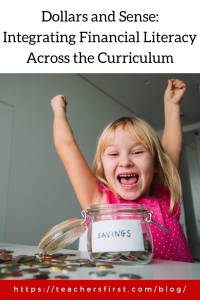In today’s world, financial literacy is a crucial skill that often gets overlooked in education. As we celebrate Financial Literacy Month in April, it’s essential to find ways to seamlessly integrate financial concepts into our students’ everyday classroom experiences.
Why Financial Literacy Matters
Students need to learn about financial literacy through cross-curricular experiences because it provides them with practical life skills. When financial concepts are integrated into various subjects, students gain a deeper understanding of money management and problem-solving through real-life situations. Learning about managing money from a young age helps students make informed decisions about their finances in the future. Plus, seeing how financial literacy connects to different areas of study helps students understand its relevance across various aspects of their lives.
Integrating Financial Literacy Across Subjects
Incorporating financial literacy into the curriculum without overburdening teachers requires creativity and integration across various subjects. Let’s explore practical strategies to integrate financial literacy experiences from math to social studies, science to language arts —every subject offers opportunities to teach essential money management skills.
Mathematics
Financial concepts align naturally with math curriculum standards. Teach students about percentages, fractions, decimals, and ratios through real-world examples such as calculating discounts, sales tax, and tip percentages. Students can also learn about budgeting, interest, and investment growth through mathematical calculations. Students grades 4–12 can learn basic money tools and other financial matters with Hands On Banking (reviewed here).
Language Arts
Integrate financial literacy into language arts lessons through reading and writing experiences. Assign students passages or articles related to personal finance, economics, or consumerism, and engage them in discussions or writing assignments that require them to analyze the text and express their opinions or arguments. Consider using Newsola’s (reviewed here) color-coded mashup of current business and finance headlines as discussion starters. Looking for a book about entrepreneurs, consumer skills, shop owners, and real people in economics or consumerism to support an activity? This CurriConnects list is a great match for units on money at any level.
Social Studies
Social studies offers numerous opportunities to explore economic principles and financial literacy. Incorporate financial concepts into lessons on economics, government, and global issues. Students can study topics such as supply and demand, economic systems, taxation, and international trade. Teach real-world financial literacy with People’s Pie (reviewed here), a simulation where students control all of the money in the United States, and Banzai (reviewed here, which allows students to learn to prioritize spending by using simulations, interactives, and “choose-your-own-adventure” style situations.
Science
While science may not seem directly related to financial literacy, students can learn about the environmental and economic impacts of energy consumption, renewable resources, and technological innovations in healthcare or agriculture. Your Plan, Your Planet (reviewed here) is an interactive that demonstrates how simple changes at home have a positive impact on our environment. Students can also create infographics sharing statistics and the financial impacts of the changes using a tool like Canva, reviewed here.
Art and Entrepreneurship
Art classes can explore the relationship between creativity and entrepreneurship. Students can learn about branding, marketing, and product design through hands-on projects. Use Canva (reviewed here) to create advertisements, design logos, social media posts, or develop prototypes for new products or services.
Physical Education and Nutrition
Integrate financial literacy into physical education classes by designing fitness challenges where students earn money for completing exercises or meeting fitness goals. They can then use their money to purchase rewards or participate in auctions, teaching them about earning, saving, and spending. Teach students about budgeting for healthy food choices by incorporating nutrition lessons into gym class.
Music and Intellectual Property
Introduce students to royalties and copyrights in the music industry. Discuss how musicians earn income through royalties from streaming platforms, radio, TV, and live performances. Teach copyright laws and protecting intellectual property using this special topic collection of Copyright and Fair Use Resources listed on TeachersFirst. Use music to teach budgeting concepts; have students write songs about budgeting, saving, and spending wisely, then perform or create music videos. Use boomy (reviewed here) to help students create their songs.
Technology and Computer Science
Technology and computer science classes provide opportunities to teach students about digital financial tools and resources. Introduce students to budgeting apps, financial management software, or online banking platforms, and have them explore how these tools can be used to track expenses, manage investments, or analyze financial data. Economic Games (reviewed here) offers over 40 multiplayer games and 14 simulations to learn economic concepts.
By integrating financial literacy across the curriculum, we can help students develop essential skills that will serve them well in their personal and professional lives. Check out this special topics collection of economics and money resources for even more classroom activities. Do you have a favorite financial literacy activity? We’d love to hear your thoughts and ideas, so please share them in the comments below.



We need to include more Financial literacy into the curriculum. Too many students leave high school with no idea how to be financially prepared.
I couldn’t agree more! My sixth-grade students participate in a program on financial literacy.